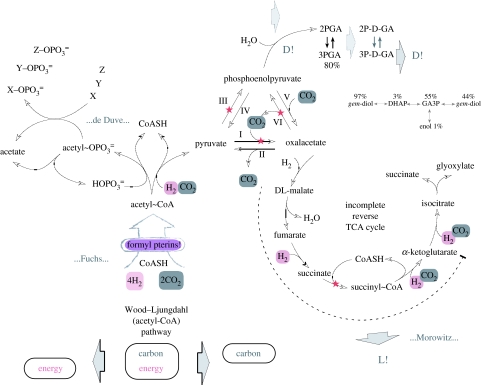Figure 3.
Schematic summary of some core reactions of carbon and energy metabolism relevant to modern biochemistry and possibly relevant to prebiotic chemistry. The names of the enzymes that catalyse the reactions labelled as I–VI interconnecting pyruvate, PEP and oxalacetate, as modified from O'Brien et al. (1977), are: I, pyruvate carboxylase; II, oxalacetate decarboxylase; III, PEP synthase (or alternatively pyruvate:orthophosphate dikinase); IV, pyruvate kinase (or alternatively pyruvate:orthophosphate dikinase); V, PEP carboxylase; VI, PEP carboxykinase. Reactions that are coupled to phosphoanhydride hydrolysis in GTP (or ATP) in the modern enzymatic reactions are labelled with a small red star. The exclamation point at formyl pterin involvement points to the bioenergetic problem of energy investment at the formyl pterin synthesis step of the Wood–Ljungdahl pathway as shown in figure 1 and as elaborated in §16. The ‘D!’ and ‘L!’ symbols indicate the points at which product chirality sets in among organisms that use the Wood–Ljungdahl pathway (see text). The references to Fuchs, de Duve and Morowitz in the figure underscore that we are merging mutually compatible aspects concerning early biochemistry that they have stressed previously into a common framework. The split from combined energy and carbon metabolism involving thioester formation from CO2 and H2 into committed energy and carbon metabolism for early biochemical evolution, both starting from the thioester acetyl-CoA (and simpler thiol analogues, such as acetyl methyl sulphide) is indicated (see text). PGA, phosphoglycerate; TCA cycle, tricarboxylic acid cycle. X, Y and Z indicate any substrate that can be phosphorylated by the acyl phosphate bond in acetyl phosphate. The isocitrate and glyoxylate steps in the modern incomplete reverse TCA cycle are apparently missing (see text). The box at right indicates aqueous equilibria in the triose phosphate system (Noltmann 1972).

